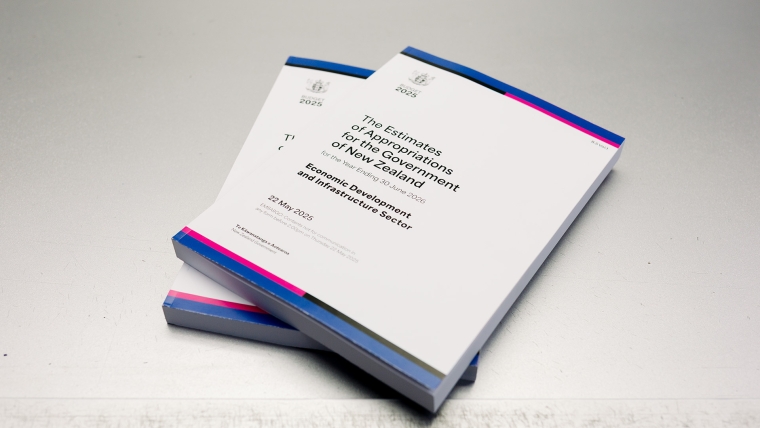
At 2pm today (Thursday), the Coalition Government will publish its second annual Budget, which is expected to fund core public services and defence upgrades while still charting a credible path to surplus this decade.
That will be difficult to achieve with just $1.3 billion in net new spending. Treasury had already warned the $2.4 billion allowances signalled in the original fiscal plan would barely cover cost pressures. Now it is $1.1 billion short.
Finance Minister Nicola Willis wants to reduce government spending as a share of economic output to better align with the current tax take. Crown revenue has lagged behind core spending since 2020, as spending has risen above 33% of gross domestic product.
This reflects the previous Labour Government’s higher spending policies, the recession suppressing GDP and tax revenue, and National’s decision to cut taxes after the election.
Willis needs to reduce spending relative to the size of the economy if she wants to avoid raising taxes or pushing public debt above Treasury’s recommended 50% ceiling. As a result, Budget 2025 will effectively be a ‘zero budget’, with no new money in real terms.
But the shortage of new cash doesn’t rule out significant changes or new policies. Willis has nearly $150 billion in the Budget to work with—not just the unallocated $1.3 billion—if she’s willing to reshuffle existing funding.
Another $4 billion will also be set aside for capital investments, including infrastructure and other tangible assets. This is separate from operating spending.
Beginnings are such delicate times
While Willis has dubbed this “The Growth Budget”, it comes at a fragile moment. Infometrics’ principal economist Nick Brunsdon said New Zealand’s long-awaited recovery had begun with “a whimper, rather than a roar”.
There were “small, tentative” signs the economy was turning a corner, particularly in rural areas driven by agriculture, but many households were still “playing it safe” as the labour market remained weak.
Some parts of the economy, including construction and manufacturing, are still contracting, and household spending fell 1.4% in the year to March.
Treasury has told the Finance Minister that the final economic forecasts in the Budget will be weaker than those in the half-year update last December. That means lower tax revenue in the coming years likely prompted her decision to cut the operating allowance.
Willis has hinted that some pro-growth policy changes in the Budget are substantial enough for Treasury to incorporate them into its forecasts — a fairly high bar. This likely relates to more generous tax treatment for capital assets.
There has been speculation the Government may allow businesses to immediately deduct the full cost of new equipment or buildings, rather than spreading it over many years.
This would incentivise investment and support productivity growth. While Willis has said ‘full capital expensing’ would cost around $8 billion a year and isn’t affordable, a more targeted version of the policy could still be included in the Budget.
Another area to watch is KiwiSaver. The Finance Minister has signalled a policy to boost balances but has not said how. Some have speculated she could lift the minimum or default contribution rate for both employers and employees.
The Budget may also include a gift to the opposition. Willis has signalled she plans to provide a policy costing agency to help political parties form credible election policies. This would likely need to be funded in this budget to be ready in time for Election 2026.
In the bag
Here’s a list of the key things already announced from Budget 2025:
Pay equity: Legislation was rushed through Parliament ahead of the Budget to raise the threshold for gender pay equity claims. This halted 33 pending cases and is expected to save the Government from having to pay “billions” for wage increases to low-paid women during the forecast period.
Healthcare: Health is one of the frontline services the Coalition wants to prioritise for spending and so it has already pre-committed to a $1.4 billion increase to cover cost pressures this year. The Government has also pre-announced $604 million over four years to allow Pharmac to purchase new cancer drugs, and $164 million over four years to expand urgent and after-hours care in remote regions.
Education: A $140 million school attendance service to tackle truancy and $100 million over four years to fund 143 full-time expert maths teachers. The sector is likely to have its cost pressures met, as it is a frontline service. That said $118 million has been reprioritised by ending a community education collaboration program, Kāhui Ako.
Industry support: The film industry will continue to get government incentives through to 2028 at least, with an extra $577 million in subsidies earmarked in the coming budget. The state-backed venture fund Elevate will also get $100 million capital injection.
Defence upgrades: The Government has outlined a $12 billion plan to significantly upgrade the NZ Defence Force’s capabilities over the next four years. Some of the details of that spending will need to be set out in the Budget. Already, $2 billion of the capital allowance has been earmarked to buy five new military helicopters.
Social investment: Willis has established a $190 million social investment fund which will commission social services from community organisations. It is a trial run for her vision of how a large portion of the $7 billion in total social spending should be distributed in the future. The Government has also set aside $774 million to compensate survivors of abuse in state care.
Trains: More than $600 million will be spent on upgrading New Zealand's rail network, with $461 million for maintenance on freight lines and another $143.6 million to replace and upgrade the Auckland and Wellington passenger lines.
Misc: $35 million over four years to hire 60 new customs officers and otherwise boost border protection. Plus $1.5 million to train, equip, and support more Māori wardens.
3 Comments
If it's a growth budget, then it should signal wholesale changes to the tax system to encourage growth (capital gains/land tax replacing some income taxes or tax free thresholds, big boost to R&D and grants systems). Almost everything else is fiddling around the edges.
I will not hold my breath.
Agreed. I’m guessing some incentives to help grow house prices again. That’s the only growth that matters, right?
It’s so disappointing that we don’t seem to invest in anything that will boost actual productivity in the long term (education, research, infrastructure that isn’t more fiscally-irresponsible roads).
Reversing / reducing the governments increasing share of the NZ economy in recent years would be a significant opportunity to improve our country's productivity.

We welcome your comments below. If you are not already registered, please register to comment.
Remember we welcome robust, respectful and insightful debate. We don't welcome abusive or defamatory comments and will de-register those repeatedly making such comments. Our current comment policy is here.